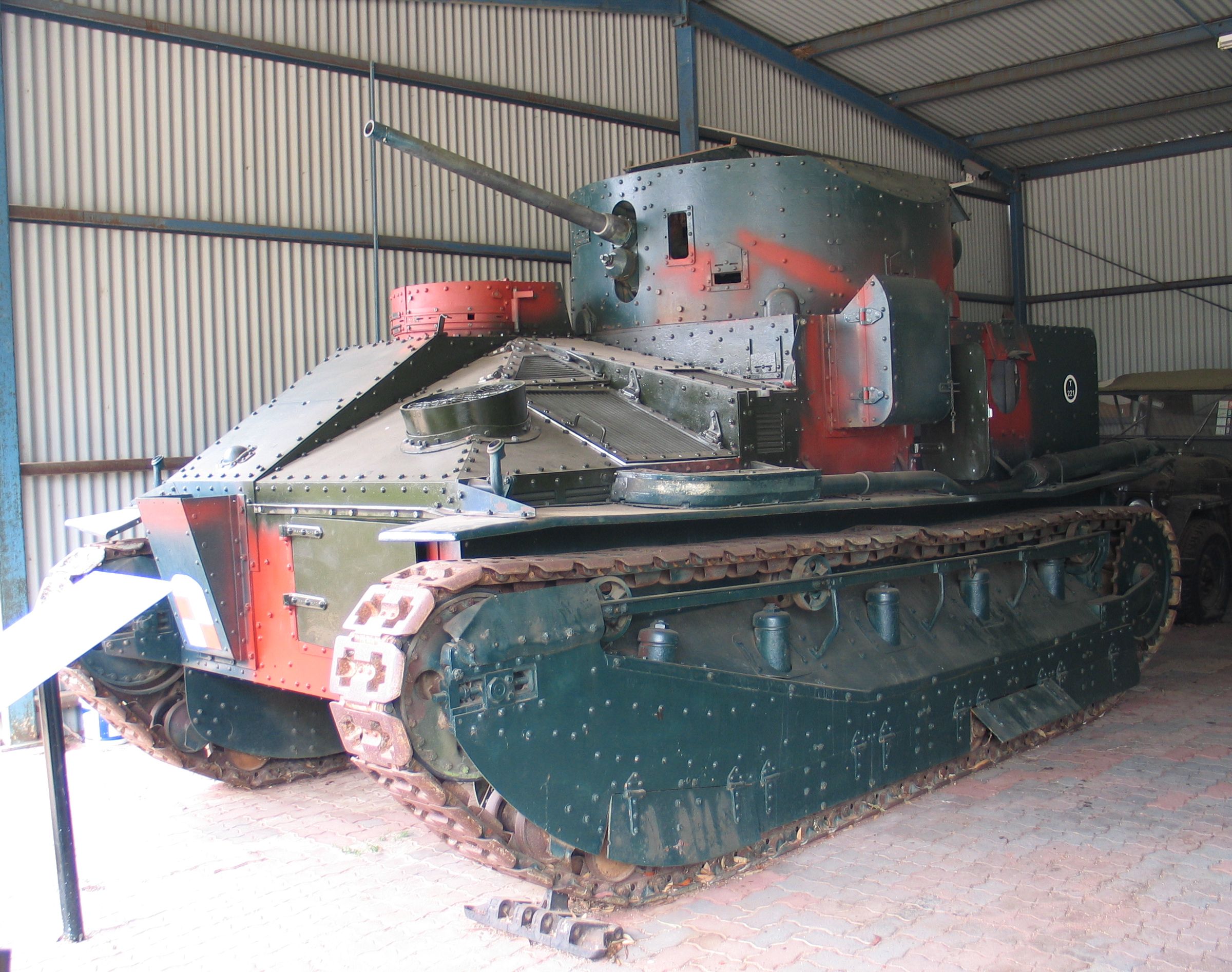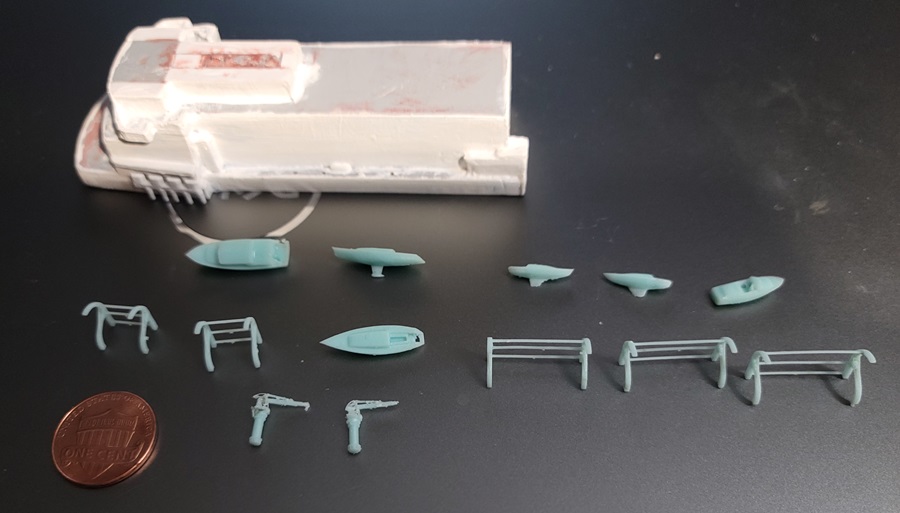1
Land / Royal Australian Marines Vickers Medium Tank Mk.II*
« Last post by Old Wombat on Today at 06:04:27 PM »Started this yesterday after pulling it out of the box to have a look at today (along with an Airfix M3 Grant tank, a Trumpeter LAV.III & a Trumpeter F9F-3 Panther).
The Mk.II* is a Hobby Boss offering & looks like a good, relatively simple build to re-start messing up the workspace after the Big Clean.
In the Real World; the Australian Army had 4 Mk.II* Specials, purchased in 1929.


Video: https://youtu.be/ouSW8srfD50
This will NOT be a Mk.II* Special, but will be one of a greater number of RAM Mk.II* tanks (I'm thinking a "Paper Battalion").
Note: The following is the mental ramblings of a demented Wombat working out the structure of the inter-war Royal Australian Marines Armoured Corps, to be slotted into the over-arching story of the History of the RAMs.
My "Paper Armoured Battalion" will have an "on paper" structure roughly akin to;
5 Companies - Headquarters Coy, A Coy, B Coy, C Coy, D Coy
Bn HQ Coy = No 1 (Battle) Group [2 x tanks, 2 x light tanks, 4 x tracked carriers, 2 x armoured cars], No 2 (Support) Group [8 x Ordnance QF 18-pounder guns (including gun tractors, crews & ammunition tractors), 10 x cargo trucks & 4 x armoured cars] & No 3 (Administration) Group [4 x armoured cars, 2 x tracked carriers, 6 x 4x4 trucks]
A - D Coy = HQ Sect'n, 1st Sect'n, 2nd Sect'n, 3rd Sect'n, 4th Sect'n
HQ Sect'n = 1 x tank, 1 x light tank, 2 x tracked carriers, 1 x armoured car
1st - 4th Sect'n = 4 x tanks
Actual strength ca. 1933;
Bn HQ = No 1 (Battle) Group [2 x tanks, 2 x light tanks, 4 x tracked carriers, 2 x armoured cars], No 2 (Support) Group [8 x Ordnance QF 18-pounder guns (including gun tractors, crews & ammunition tractors), 10 x cargo trucks & 4 x armoured cars] & No 3 (Administration) Group [4 x armoured cars, 2 x tracked carriers, 6 x 4x4 trucks]
A - B Coy = HQ Sect'n, 1st Sect'n, 2nd Sect'n
HQ Sect'n = 1 x tank, 1 x light tank, 2 x tracked carriers/4x4 trucks (depending on availability), 1 x armoured car
1st - 2nd Sect'n = 4 x tanks/light tanks/tracked carriers/armoured cars (depending on availability)
This was acheived with 10 x Vickers Medium Mk.II*s (3 were generally kept off-line for major maintenance at any given time), 6 x Vickers Light tank Mk.IVs (replaced by Mk.VIs from 1937), 6 x modified 2nd-hand Vickers Medium Mk.I tanks cut down & used as cargo/troop carriers, 10 Rolls Royce 1920-Pattern armoured cars & a mix of Marmon-Herrington & Dodge 4x4 trucks (usually around 20 in number).
The PAB will be heavy in officers & NCOs, with a strong focus on command, initiative, coordination, innovation & determination. Thus setting itself up to carefully expand to full battalion strength in early 1937, & its ability to clone itself multiple times over in quick succession after war is declared in September 1939.
********************************************************************************************************************************************************
I'm sticking with a standard Mk.II* in an unusual environment (Australia) ... possibly camouflaged in a Solomon scheme variant;
From: http://www.landships.info/landships/tank_articles/Solomon_Camouflage.html
The Mk.II* is a Hobby Boss offering & looks like a good, relatively simple build to re-start messing up the workspace after the Big Clean.
In the Real World; the Australian Army had 4 Mk.II* Specials, purchased in 1929.


Video: https://youtu.be/ouSW8srfD50
This will NOT be a Mk.II* Special, but will be one of a greater number of RAM Mk.II* tanks (I'm thinking a "Paper Battalion").
Note: The following is the mental ramblings of a demented Wombat working out the structure of the inter-war Royal Australian Marines Armoured Corps, to be slotted into the over-arching story of the History of the RAMs.
My "Paper Armoured Battalion" will have an "on paper" structure roughly akin to;
5 Companies - Headquarters Coy, A Coy, B Coy, C Coy, D Coy
Bn HQ Coy = No 1 (Battle) Group [2 x tanks, 2 x light tanks, 4 x tracked carriers, 2 x armoured cars], No 2 (Support) Group [8 x Ordnance QF 18-pounder guns (including gun tractors, crews & ammunition tractors), 10 x cargo trucks & 4 x armoured cars] & No 3 (Administration) Group [4 x armoured cars, 2 x tracked carriers, 6 x 4x4 trucks]
A - D Coy = HQ Sect'n, 1st Sect'n, 2nd Sect'n, 3rd Sect'n, 4th Sect'n
HQ Sect'n = 1 x tank, 1 x light tank, 2 x tracked carriers, 1 x armoured car
1st - 4th Sect'n = 4 x tanks
Actual strength ca. 1933;
Bn HQ = No 1 (Battle) Group [2 x tanks, 2 x light tanks, 4 x tracked carriers, 2 x armoured cars], No 2 (Support) Group [8 x Ordnance QF 18-pounder guns (including gun tractors, crews & ammunition tractors), 10 x cargo trucks & 4 x armoured cars] & No 3 (Administration) Group [4 x armoured cars, 2 x tracked carriers, 6 x 4x4 trucks]
A - B Coy = HQ Sect'n, 1st Sect'n, 2nd Sect'n
HQ Sect'n = 1 x tank, 1 x light tank, 2 x tracked carriers/4x4 trucks (depending on availability), 1 x armoured car
1st - 2nd Sect'n = 4 x tanks/light tanks/tracked carriers/armoured cars (depending on availability)
This was acheived with 10 x Vickers Medium Mk.II*s (3 were generally kept off-line for major maintenance at any given time), 6 x Vickers Light tank Mk.IVs (replaced by Mk.VIs from 1937), 6 x modified 2nd-hand Vickers Medium Mk.I tanks cut down & used as cargo/troop carriers, 10 Rolls Royce 1920-Pattern armoured cars & a mix of Marmon-Herrington & Dodge 4x4 trucks (usually around 20 in number).
The PAB will be heavy in officers & NCOs, with a strong focus on command, initiative, coordination, innovation & determination. Thus setting itself up to carefully expand to full battalion strength in early 1937, & its ability to clone itself multiple times over in quick succession after war is declared in September 1939.
********************************************************************************************************************************************************
I'm sticking with a standard Mk.II* in an unusual environment (Australia) ... possibly camouflaged in a Solomon scheme variant;
Quote
Mother was the first tank to be painted, on June 16. Solomon had a detachment of six men to assist him, but preferred to personally paint the machines. In his 1937 memoir, Basil Henriques, an officer of C Company, recalls him painting "..as if he were covering a canvas for the Royal Academy." A rather indistinct photo of Mother, probably taken in the winter of 1916-17, shows her in this camouflage scheme.
Mother in camouflage (Coventry Transport Museum)
Solomonís diary does not describe his camouflage scheme, but Henriques recalls that "The effect was a kind of rather jolly landscape in green against a pink sunset sky." Camouflage covers for the tanks were also painted. The tank crews were instructed to copy his design, which they did "..with great care but little skill." Trevor Pidgeon has noted that a well-known photograph of a Mk.I, usually captioned as going into action at Flers- Courcellette, must have been actually taken at Elveden. If this is the case, it may be the only known photograph of camouflaged Mk.I taken before the tanks were sent to France, and shows a camouflage pattern similar to Solomon's scheme as seen on Mother..
A Mk.I at Elveden (IWM)
The Tanks in France
Henriques recalls with chagrin that "..no sooner had we disembarked in France than we were immediately ordered to paint over our landscape with a bold pattern of brown, broken by broad black lines." A camouflage expert with the B.E.F. had judged Solomonís scheme to be unsuitable. In fairness to Solomon, he had made his observations of largely intact landscapes in springtime. No one could have foreseen the appearance of the Sommeís shattered wasteland in late summer. Lt. Head, of D Company, also comments that the tanks were camouflaged at Yvrench. Perry Robinson, a war correspondent for the Times, closely observed the tanks after they had been repainted, on the eve of their first engagement. Writing in 1917, he states that "The brutes were all painted in blotched reptilian colours, hues of rattlesnake and iguana, yellow and dull grey and black and mottled brown, and in the failing light, against the brown-green earth, they were strangely invisible." When comparing the photographs taken in France to that of the Elveden tank, it is evident that Solomonís irregular, blotched pattern had been largely retained, despite the change of colour scheme. A close examination, however, reveals subtle differences in pattern from this vehicle, and between the tanks of A, C and D Company. This may be the result of each companyís arrival in France at a different time. It must be conceded, however, that a considerable overlap in camouflage style exists within the companies which fought on the Somme, and only a minority of their 85 machines seem to have been photographed. The predominant C Company pattern bears the most resemblance to the Elveden vehicle. The colour blotches are interspersed with broad bands of black , of varying thickness and irregular border. Some of the blotches appear to contain small daubs of a lighter colour, perhaps as a result of hasty over-painting, although this can also be seen on the Elveden tank.
C.19 (Tank Museum)
D Company seems to have favoured using more uniform black stripes to outline the patches of colour.
D.17 (AWM)
The Mk.II tank at Bovington, which would not have received an original Solomon paint scheme, was modified and painted to resemble a Mk.I, and was on display in Chertsey the 1940s. This vehicle seems to have been the model for the Airfix kit, and its artwork.
The Hatfield Park Mk.I, now at Bovington (Tank Museum)
From: http://www.landships.info/landships/tank_articles/Solomon_Camouflage.html



 Recent Posts
Recent Posts








